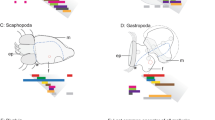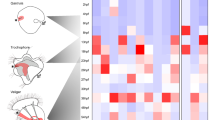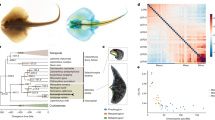Abstract
The fin-to-limb transition represents one of the major vertebrate morphological innovations associated with the transition from aquatic to terrestrial life and is an attractive model for gaining insights into the mechanisms of morphological diversity between species1. One of the characteristic features of limbs is the presence of digits at their extremities. Although most tetrapods have limbs with five digits (pentadactyl limbs), palaeontological data indicate that digits emerged in lobed fins of early tetrapods, which were polydactylous2. How the transition to pentadactyl limbs occurred remains unclear. Here we show that the mutually exclusive expression of the mouse genes Hoxa11 and Hoxa13, which were previously proposed to be involved in the origin of the tetrapod limb1,2,3,4,5,6, is required for the pentadactyl state. We further demonstrate that the exclusion of Hoxa11 from the Hoxa13 domain relies on an enhancer that drives antisense transcription at the Hoxa11 locus after activation by HOXA13 and HOXD13. Finally, we show that the enhancer that drives antisense transcription of the mouse Hoxa11 gene is absent in zebrafish, which, together with the largely overlapping expression of hoxa11 and hoxa13 genes reported in fish3,4,5,6,7, suggests that this enhancer emerged in the course of the fin-to-limb transition. On the basis of the polydactyly that we observed after expression of Hoxa11 in distal limbs, we propose that the evolution of Hoxa11 regulation contributed to the transition from polydactyl limbs in stem-group tetrapods to pentadactyl limbs in extant tetrapods.
This is a preview of subscription content, access via your institution
Access options
Subscribe to this journal
Receive 51 print issues and online access
$199.00 per year
only $3.90 per issue
Buy this article
- Purchase on Springer Link
- Instant access to full article PDF
Prices may be subject to local taxes which are calculated during checkout




Similar content being viewed by others
References
Shubin, N., Tabin, C. & Carroll, S. Deep homology and the origins of evolutionary novelty. Nature 457, 818–823 (2009)
Coates, M. I., Jeffery, J. E. & Rut, M. Fins to limbs: what the fossils say. Evol. Dev. 4, 390–401 (2002)
Davis, M. C., Dahn, R. D. & Shubin, N. H. An autopodial-like pattern of Hox expression in the fins of a basal actinopterygian fish. Nature 447, 473–476 (2007)
Metscher, B. D. et al. Expression of Hoxa-11 and Hoxa-13 in the pectoral fin of a basal ray-finned fish, Polyodon spathula: implications for the origin of tetrapod limbs. Evol. Dev. 7, 186–195 (2005)
Sakamoto, K. et al. Heterochronic shift in Hox-mediated activation of sonic hedgehog leads to morphological changes during fin development. PLoS One 4, e5121 (2009)
Sordino, P., Duboule, D. & Kondo, T. Zebrafish Hoxa and Evx-2 genes: cloning, developmental expression and implications for the functional evolution of posterior Hox genes. Mech. Dev. 59, 165–175 (1996)
Ahn, D. & Ho, R. K. Tri-phasic expression of posterior Hox genes during development of pectoral fins in zebrafish: implications for the evolution of vertebrate paired appendages. Dev. Biol. 322, 220–233 (2008)
Shubin, N., Tabin, C. & Carroll, S. Fossils, genes and the evolution of animal limbs. Nature 388, 639–648 (1997)
Wagner, G. P. & Chiu, C. H. The tetrapod limb: a hypothesis on its origin. J. Exp. Zool. 291, 226–240 (2001)
Sordino, P., van der Hoeven, F. & Duboule, D. Hox gene expression in teleost fins and the origin of vertebrate digits. Nature 375, 678–681 (1995)
Freitas, R., Zhang, G. & Cohn, M. J. Biphasic Hoxd gene expression in shark paired fins reveals an ancient origin of the distal limb domain. PLoS One 2, e754 (2007)
Freitas, R., Gómez-Marín, C., Wilson, J. M., Casares, F. & Gómez-Skarmeta, J. L. Hoxd13 contribution to the evolution of vertebrate appendages. Dev. Cell 23, 1219–1229 (2012)
Woltering, J. M., Noordermeer, D., Leleu, M. & Duboule, D. Conservation and divergence of regulatory strategies at Hox loci and the origin of tetrapod digits. PLoS Biol . 12, e1001773 (2014)
Fromental-Ramain, C. et al. Hoxa-13 and Hoxd-13 play a crucial role in the patterning of the limb autopod. Development 122, 2997–3011 (1996)
Schneider, I. & Shubin, N. H. The origin of the tetrapod limb: from expeditions to enhancers. Trends Genet . 29, 419–426 (2013)
Montavon, T. et al. A regulatory archipelago controls Hoix genes transcription in digits. Cell 147, 1132–1145 (2011)
Berlivet, S. et al. Clustering of tissue-specific sub-TADs accompanies the regulation of HoxA genes in developing limbs. PLoS Genet . 9, e1004018 (2013)
Gehrke, A. R. et al. Deep conservation of wrist and digit enhancers in fish. Proc. Natl Acad. Sci. USA 112, 803–808 (2015)
Sheth, R., Bastida, M. F., Kmita, M. & Ros, M. “Self-regulation,” a new facet of Hox genes’ function. Dev. Dyn. 243, 182–191 (2014)
Hsieh-Li, H. M. et al. Hoxa 11 structure, extensive antisense transcription, and function in male and female fertility. Development 121, 1373–1385 (1995)
Potter, S. S. & Branford, W. W. Evolutionary conservation and tissue-specific processing of Hoxa 11 antisense transcripts. Mamm. Genome 9, 799–806 (1998)
Leite-Castro, J., Beviano, V., Rodrigues, P. N., Freitas, R. & Hox, A. Genes and the fin-to-limb transition in vertebrates. J. Dev. Biol . 4, 10 (2016)
Small, K. M. & Potter, S. S. Homeotic transformations and limb defects in Hox A11 mutant mice. Genes Dev . 7, 2318–2328 (1993)
Nelson, L. T., Rakshit, S., Sun, H. & Wellik, D. M. Generation and expression of a Hoxa11eGFP targeted allele in mice. Dev. Dyn. 237, 3410–3416 (2008)
Scotti, M., Kherdjemil, Y., Roux, M. & Kmita, M. A Hoxa13:Cre mouse strain for conditional gene manipulation in developing limb, hindgut, and urogenital system. Genesis 53, 366–376 (2015)
Logan, M. et al. Expression of Cre recombinase in the developing mouse limb bud driven by a Prxl enhancer. Genesis 33, 77–80 (2002)
Kmita, M., Fraudeau, N., Hérault, Y. & Duboule, D. Serial deletions and duplications suggest a mechanism for the collinearity of Hoxd genes in limbs. Nature 420, 145–150 (2002)
Takamatsu, N. et al. Duplicated Abd-B class genes in medaka hoxAa and hoxAb clusters exhibit differential expression patterns in pectoral fin buds. Dev. Genes Evol. 217, 263–273 (2007)
Ulitsky, I., Shkumatava, A., Jan, C. H., Sive, H. & Bartel, D. P. Conserved function of lincRNAs in vertebrate embryonic development despite rapid sequence evolution. Cell 147, 1537–1550 (2011)
Kmita, M., Kondo, T. & Duboule, D. Targeted inversion of a polar silencer within the HoxD complex re-allocates domains of enhancer sharing. Nat. Genet. 26, 451–454 (2000)
Murtaugh, L. C., Stanger, B. Z., Kwan, K. M. & Melton, D. A. Notch signaling controls multiple steps of pancreatic differentiation. Proc. Natl Acad. Sci. USA 100, 14920–14925 (2003)
Soriano, P. Generalized lacZ expression with the ROSA26 Cre reporter strain. Nat. Genet. 21, 70–71 (1999)
Cong, L. et al. Multiplex genome engineering using CRISPR/Cas systems. Science 339, 819–823 (2013)
Sheth, R. et al. Hox genes regulate digit patterning by controlling the wavelength of a Turing-type mechanism. Science 338, 1476–1480 (2012)
Scotti, M. & Kmita, M. Recruitment of 5′ Hoxa genes in the allantois is essential for proper extra-embryonic function in placental mammals. Development 139, 731–739 (2012)
Mattar, P. et al. Basic helix-loop-helix transcription factors cooperate to specify a cortical projection neuron identity. Mol. Cell. Biol. 28, 1456–1469 (2008)
Yelon, D., Horne, S. A. & Stainier, D. Y. Restricted expression of cardiac myosin genes reveals regulated aspects of heart tube assembly in zebrafish. Dev. Biol. 214, 23–37 (1999)
Thisse, C. & Thisse, B. High-resolution in situ hybridization to whole-mount zebrafish embryos. Nat. Protocols 3, 59–69 (2008)
Acknowledgements
We thank Q. Zhu and L. Lian from the IRCM transgenic core facility for the ES cell work and production of transgenic mouse lines. We are particularly grateful to A. Kania for critical reading of the manuscript as well as laboratory members for insightful discussions and sharing reagents. This work was supported by the Canadian Institute for Health Research (MOP-115127) and the Canada Research Chair program to M.K. (RCHS0192), the Natural Sciences and Engineering Research Council of Canada (155817-2012) to M.-A.A. and Shriners Hospital Research grant 85400 to H.S.S. Y.K. was supported by a fellowship from the Molecular Biology program of the Université de Montréal and the IRCM fellowship Michel-Bélanger. R.S. was supported by a post-doctoral fellowship from the Canadian Institute for Health Research. D.M.W. and K.M.P. were supported by NIH NIAMS AR061402, with K.M.P. additionally supported by NIH T32 DE007057.
Author information
Authors and Affiliations
Contributions
Y.K. and M.K. conceived the study and analysed the data. Y.K. designed and conducted all mouse experiments with the help of R.S. for the generation of the mouse lines. All fish experiments were performed by R.L.L. under the supervision of M.-A.A. R.S. performed the ChIP–seq experiments. A.D. provided technical help for the mouse experiments. G.M. performed preliminary experiments related to Figs 2a and 3c, e. D.M.W. and K.M.P provided Hoxa11eGFP/eGFP embryos. H.S.S. provided the HOXA13 and HOXD13 antibodies. M.K. wrote the paper. All authors commented on the manuscript.
Corresponding author
Ethics declarations
Competing interests
The authors declare no competing financial interests.
Additional information
Reviewer Information Nature thanks R. Freitas, J. L. Gomez-Skarmeta and S. Mackem for their contribution to the peer review of this work.
Extended data figures and tables
Extended Data Figure 1 Absence of antisense transcription 3′ to the Hoxa11 promoter in the Hoxa11eGFP/eGFP limb and evidence that Hoxa11as-b transcripts produced in trans have no effect on Hoxa11 expression.
a, b, Detection of Hoxa11as-b transcripts in wild-type limb buds at E12.5 (a), and whole-mount in situ hybridization to detect gfp antisense transcripts in Hoxa11eGFP/eGFP limb buds at E12.5 (b). c–e, Hoxa11 expression in wild-type limb buds (c), and Hoxa11as-b (d) and Hoxa11 (e) expression in Prx1-Hoxa11as limb buds. Original magnification, ×31.5.
Extended Data Figure 2 Deletion of the distal enhancer in Hoxa11 intron using CRISPR-Cas9.
a, Scheme of the wild-type and targeted (Hoxa11ΔInt) loci. Sites targeted by the single-guide RNAs (sgRNA_1 and sgRNA_2) for the CRISPR-Cas9-mediated deletion of the distal enhancer. The blue rectangles indicate the position of the DNA probe used to confirm the deletion by Southern blot in b. b, Lane 1 shows the 6-kb KpnI band resulting from the CRISPR-Cas9-mediated deletion. Lane 2 was loaded with wild-type DNA. c, PCR reaction using a forward primer located upstream of sgRNA_1 and a reverse primer located downstream sgRNA_2 shows the presence of a 300 bp (ΔInt 300 bp) fragment expected for the Hoxa11ΔInt allele. d, The sequence of the 300-bp PCR fragment confirms the CRISPR-Cas9-mediated deletion of the Hoxa11 intronic region containing the distal enhancer (only the sequence encompassing the deletion breakpoints is shown).
Extended Data Figure 3 The distal enhancer located in the Hoxa11 intron is bound by HOXA13 and HOXD13 in distal limb cells and its activity is increased by HOXA13 in 293T cells.
a, Integrative genomics viewer (IGV) screenshot showing HOXA13 and HOXD13 ChIP–seq data at the Hoxa11 locus. These ChIP–seq data were obtained using chromatin from distal forelimb buds of wild-type E11.5 mouse embryos (R. Sheth et al., manuscript submitted). b, Transfection assay shows HOXA13 dependent activation of Hoxa11 intron driving reporter gene expression. Two-tailed Tukey’s multiple comparisons test was performed. Error bars indicate s.d (n = 3). RQ, relative quantification.
Extended Data Figure 4 Individual inactivation of Hoxa13 or Hoxd13 is not sufficient to fully abrogate antisense transcription in distal limbs.
a, b, Whole-mount in situ hybridization, using probe A (see Fig. 1) to detect all antisense transcripts, on Hoxd13−/− (a) and Hoxa13−/− (b) mouse limb buds at E11.5. Antisense transcription in distal limbs remains robust in both mutants but a clear reduction is seen in the distal Hoxa13−/− limbs. Original magnification, ×31.5.
Extended Data Figure 5 Inactivation of both Hoxa13 and Hoxd13 disrupts antisense transcription overlapping with the Hoxa11 exon 1.
a–d, Hoxa11as-b expression (probe B in Fig. 1) in limb buds (a, b) and tail buds (c, d) from wild-type (a, c) and Hoxa13−/− Hoxd13−/− (b, d) E12.5 mouse embryos. Whole-mount in situ hybridization shows that Hoxa11as-b expression in tail buds (internal control) is similar in both the wild-type (c) and double-mutant (d) embryos, whereas there is almost no expression remaining in Hoxa13−/− Hoxd13−/− limb buds (b). Original magnification, ×31.5.
Extended Data Figure 6 Generation of the RosaHoxa11 knock-in mouse line.
a, Targeting of the endogenous Rosa26 locus (top three lines). The wild-type Rosa26 locus is shown below (middle). Regions used as homologous arms for the recombination in ES cells are indicated by brown rectangles labelled 5′ and 3′, respectively. Scheme of the targeted locus after homologous recombination in ES cells and after Cre-mediated recombination is shown at the bottom. The position of the internal (IP) and external (EP) probes and restriction sites used for Southern blot analysis are indicated on both the wild-type and targeted locus. b, c, Southern blots of ES cells clones using the internal probe (b) and external probe (c) to detect the targeted allele (lane 1). d, Southern blot of wild-type (lane 2) and heterozygous (lane 1) mice. A, AscI; E, EcoRV; P, PacI; S, SwaI.
Extended Data Figure 7 The conditional gain of Hoxa11 using the Hoxa13Cre allele results in the formation of supernumerary digits.
a, b, Autopod of RosaHoxa11/+ (a) and RosaHoxa11 Hoxa13Cre (b) at E15.5. Anterior is up. The Rosa26 locus and Hoxa13Cre allele being on the same chromosome (Chr6), the gain-of-function phenotype was assessed with only one copy of the RosaHoxa11 allele. c–e, Autopod skeletons of Prx1Cre; RosaHoxa11/Hoxa11 mice at P0 from four distinct mutants (anterior is up). The number of digits varies from 6 to 7, with often a small post-axial extra-digit (posterior). The extra-digit phenotype is fully penetrant upon Cre-activation of two copies of the RosaHoxa11 allele (n = 10). Original magnification, ×20.d, Quantification of Hoxa11 expression level by quantitative reverse transcriptase PCR (RT–qPCR) on RNA extracted from E11.5 forelimb, relative to both Gapdh and Tbp mRNA of Prx1Cre; RosaHoxa11/Hoxa11 embryos. Two-tailed t-test was performed. Error bars indicate s.d (n = 4).
Extended Data Figure 8 hoxa11 and hoxa13 are expressed in overlapping domains in zebrafish fins.
a–d, Expression of hoxa13b (a, b) and hoxa11b (c, d) in zebrafish fins at 60 hpf (a, c) and 72 hpf (b, d). Dotted lines indicate the boundary between the endochondral disc and the fin fold. Original magnification, ×400.
Extended Data Figure 9 Absence of antisense transcription at the hoxa11a and hoxa11b loci in zebrafish fins.
a, b, Whole-mount in situ hybridization with probes designed to detect putative antisense transcription at hoxa11a (a) and hoxa11b (b). c–f, No antisense transcription is detected, whereas expression of hoxa11a (c), hoxa11b (d), hoxa13a (e) and hoxa13b (f) is observed in zebrafish fins at the same stage. Asterisks correspond to the staining from the fin on the other side of the embryo. Original magnification, ×63.
Rights and permissions
About this article
Cite this article
Kherdjemil, Y., Lalonde, R., Sheth, R. et al. Evolution of Hoxa11 regulation in vertebrates is linked to the pentadactyl state. Nature 539, 89–92 (2016). https://doi.org/10.1038/nature19813
Received:
Accepted:
Published:
Issue Date:
DOI: https://doi.org/10.1038/nature19813
This article is cited by
-
Nr6a1 controls Hox expression dynamics and is a master regulator of vertebrate trunk development
Nature Communications (2022)
-
Mesomelic dysplasias associated with the HOXD locus are caused by regulatory reallocations
Nature Communications (2021)
-
HOX13-dependent chromatin accessibility underlies the transition towards the digit development program
Nature Communications (2020)
-
Regulation of gene expression by cis-acting long non-coding RNAs
Nature Reviews Genetics (2020)
-
Exploratory Evidence of Sex-Dimorphic Associations of the Ulna-to-Fibula Ratio, a Potential Marker of Pubertal Sex Steroid Exposure, with the Implicit Need for Power
Adaptive Human Behavior and Physiology (2020)
Comments
By submitting a comment you agree to abide by our Terms and Community Guidelines. If you find something abusive or that does not comply with our terms or guidelines please flag it as inappropriate.



